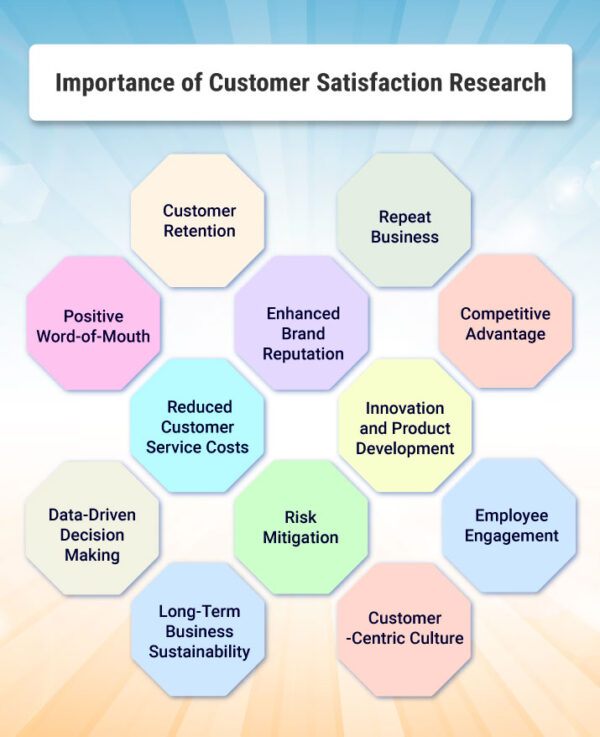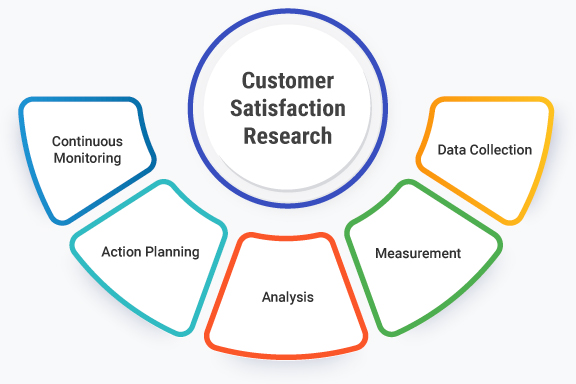What is Customer Satisfaction Research?
Customer Satisfaction Research is defined as a systematic process of collecting, analyzing, and interpreting feedback and data from customers to assess their level of satisfaction with a product, service, or overall experience provided by a company. This research aims to measure and understand customers’ perceptions, expectations, and sentiments regarding their interactions with a business. The primary goal of customer satisfaction research is to identify areas where a company can improve its offerings and customer service to enhance customer loyalty, retention, and overall business success.
Key components of customer satisfaction research include:
- Data Collection: Gathering feedback and data from customers can be done through various methods, including surveys, interviews, focus groups, online review analysis, and social media monitoring. The choice of data collection method depends on the research objectives and the nature of the business.
- Measurement: Customer satisfaction is typically measured on a scale, often ranging from highly satisfied to highly dissatisfied. Common scales include Likert scales (e.g., 1 to 5 or 1 to 7), Net Promoter Score (NPS), or a simple yes/no response to a satisfaction question.
- Analysis: After collecting data, researchers analyze it to identify trends, patterns, and correlations. This analysis helps in understanding the factors that influence customer satisfaction, as well as areas where improvements are needed.
- Action Planning: Based on the insights gained from the research, businesses develop action plans to address areas of dissatisfaction or improvement. These plans may involve changes to products, services, customer support, or other aspects of the customer experience.
- Continuous Monitoring: Customer satisfaction research is an ongoing process. Companies regularly collect and analyze customer feedback to ensure that improvements are effective and that satisfaction levels are consistently high.
Customer satisfaction research serves several essential purposes for businesses:
- Identifying Weaknesses: It helps businesses pinpoint specific areas or touchpoints where customers are dissatisfied, allowing for targeted improvements.
- Enhancing Customer Loyalty: Satisfied customers are more likely to remain loyal and continue doing business with a company. Research helps in understanding what drives customer loyalty.
- Reputation Management: Positive customer experiences can lead to positive word-of-mouth, while negative experiences can harm a company’s reputation. Research helps in managing and improving brand perception.
- Competitive Advantage: Businesses can use customer satisfaction research to outperform competitors by providing superior products and services that align with customer expectations.
- Innovation: Customer feedback often contains valuable ideas for innovation and product development, which can drive growth and market differentiation.
Customer satisfaction research is a systematic approach to understanding and improving customer experiences. It plays a crucial role in helping businesses meet customer expectations, enhance loyalty, and ultimately achieve long-term success in a competitive market.
Importance of Customer Satisfaction Research

The importance of customer satisfaction research cannot be overstated in today’s business environment. It serves as a vital tool for companies to understand, measure, and enhance their customers’ contentment and overall experience. Here are some key reasons why customer satisfaction research is of utmost importance:
1. Customer Retention: Satisfied customers are more likely to remain loyal and continue doing business with a company. Customer satisfaction research helps in identifying areas where improvements are needed to retain existing customers, reduce churn rates, and preserve valuable revenue streams.
2. Repeat Business: Happy customers are more likely to make repeat purchases and engage in ongoing business relationships. Understanding what satisfies your customers can lead to increased sales and higher customer lifetime value.
3. Positive Word-of-Mouth: Satisfied customers often become brand advocates. They are more likely to recommend your products or services to others, leading to positive word-of-mouth marketing. This organic promotion can attract new customers at a reduced acquisition cost.
4. Enhanced Brand Reputation: High levels of customer satisfaction contribute to a positive brand reputation. When customers consistently have positive experiences with your business, your brand becomes associated with quality, reliability, and trustworthiness.
5. Competitive Advantage: In a competitive marketplace, delivering exceptional customer experiences can set your business apart from rivals. Customer satisfaction research helps you identify areas where you can outperform your competition and gain a competitive edge.
6. Reduced Customer Service Costs: By addressing common pain points and improving customer satisfaction, you can reduce the number of support inquiries and complaints. This can lead to lower customer service costs and improved operational efficiency.
7. Innovation and Product Development: Customer feedback collected through research often contains valuable insights and ideas for innovation and product development. Understanding customer needs and preferences can guide the creation of new offerings that align with market demands.
8. Data-Driven Decision Making: Customer satisfaction research provides data and metrics that can guide strategic decision-making. It allows businesses to make informed choices about product improvements, marketing strategies, and resource allocation.
9. Risk Mitigation: Identifying and addressing customer dissatisfaction early can help mitigate the risk of negative public relations incidents, customer defection, or legal issues resulting from customer complaints.
10. Employee Engagement: Satisfied customers often coincide with engaged and motivated employees. Employees who see the positive impact of their work on customer satisfaction are more likely to be enthusiastic and committed to their roles.
11. Long-Term Business Sustainability: Maintaining high levels of customer satisfaction contributes to the long-term sustainability and growth of a business. It helps create a stable customer base that provides ongoing revenue.
12. Customer-Centric Culture: Customer satisfaction research fosters a customer-centric culture within a company, where employees are encouraged to prioritize customer needs and continuously seek ways to improve the customer experience.
Customer satisfaction research is a powerful tool for businesses to gauge customer sentiment, identify areas for improvement, and ultimately enhance customer loyalty and profitability. In an era where customer expectations are continually evolving, understanding and meeting those expectations is essential for long-term success. By actively investing in customer satisfaction research, businesses can adapt and thrive in an ever-changing marketplace.
Learn more: What is Customer Research?
Process of Customer Satisfaction Research
The process of conducting customer satisfaction research involves several key steps to gather, analyze, and act upon feedback and data from customers. Here is a step-by-step guide to conducting customer satisfaction research:
1. Define Research Objectives
Clearly define the goals and objectives of your customer satisfaction research. What specific aspects of customer satisfaction do you want to measure or improve? Are you focused on overall satisfaction, product satisfaction, service satisfaction, or a combination of these?
2. Select Research Methods
Choose the appropriate research methods that align with your objectives. Common methods include surveys, interviews, focus groups, online review analysis, social media monitoring, and feedback forms. Consider the advantages and limitations of each method and select the one(s) that best suits your needs.
3. Identify Your Target Audience
Define your target audience or customer segment for the research. Ensure that your sample group is representative of your customer base to obtain accurate insights.
4. Create Research Instruments
Develop the research instruments, such as survey questionnaires, interview scripts, or discussion guides. Make certain that your queries are precise, impartial, and closely linked to your research goals.
5. Data Collection
Implement your chosen research methods to collect data from customers. This may involve distributing surveys, conducting interviews or focus groups, monitoring online reviews and social media mentions, or providing feedback forms at various touchpoints.
6. Analyze Data
Once data is collected, analyze it systematically. Look for trends, patterns, and correlations in the responses. Use statistical analysis techniques to draw meaningful insights from the data.
7. Interpret Findings
Analyze the discoveries within the framework of your research objectives. What do the data and insights reveal about customer satisfaction levels and the factors influencing them? Recognize the strengths and shortcomings in your offerings.
8. Segmentation
Segment your data based on various criteria (e.g., demographics, purchase history, customer loyalty) to uncover specific trends within different customer groups. This allows for more targeted action plans.
9. Benchmarking
Compare your customer satisfaction metrics to industry benchmarks or your own historical data to gauge your performance relative to others or your past performance.
10. Action Planning
Develop actionable strategies and plans based on the insights gained from the research. Pinpoint precise areas requiring enhancement and establish their priority. Develop a plan for addressing these concerns.
11. Implementation
Put your action plans into practice. Implement changes, whether they involve product improvements, service enhancements, or process optimizations. Ensure that relevant teams are aligned and committed to executing these changes.
12. Monitoring and Feedback Loop
Continuously monitor the impact of your improvements. Collect ongoing customer feedback through surveys or other channels to assess whether the changes are positively affecting customer satisfaction.
13. Communication
Share the results of your customer satisfaction research with key stakeholders within your organization. Transparency and collaboration are essential for garnering support and resources for improvement initiatives.
14. Iterate and Repeat
Customer satisfaction research should be an ongoing process. Regularly repeat the research to track changes in customer sentiment and satisfaction levels. Use the feedback loop to iterate and refine your strategies.
15. Celebrate Success
Acknowledge and celebrate successes and improvements in customer satisfaction. Recognize the efforts of teams involved in the process to maintain motivation and commitment to ongoing improvement.
By following these steps in the customer satisfaction research process, businesses can continuously enhance the customer experience, improve customer loyalty, and ultimately achieve long-term success in the marketplace.
Learn more: What is Customer Feedback Analysis?
Most Recent Blogs
Explore the latest innovation insights and trends with our recent blog posts.










